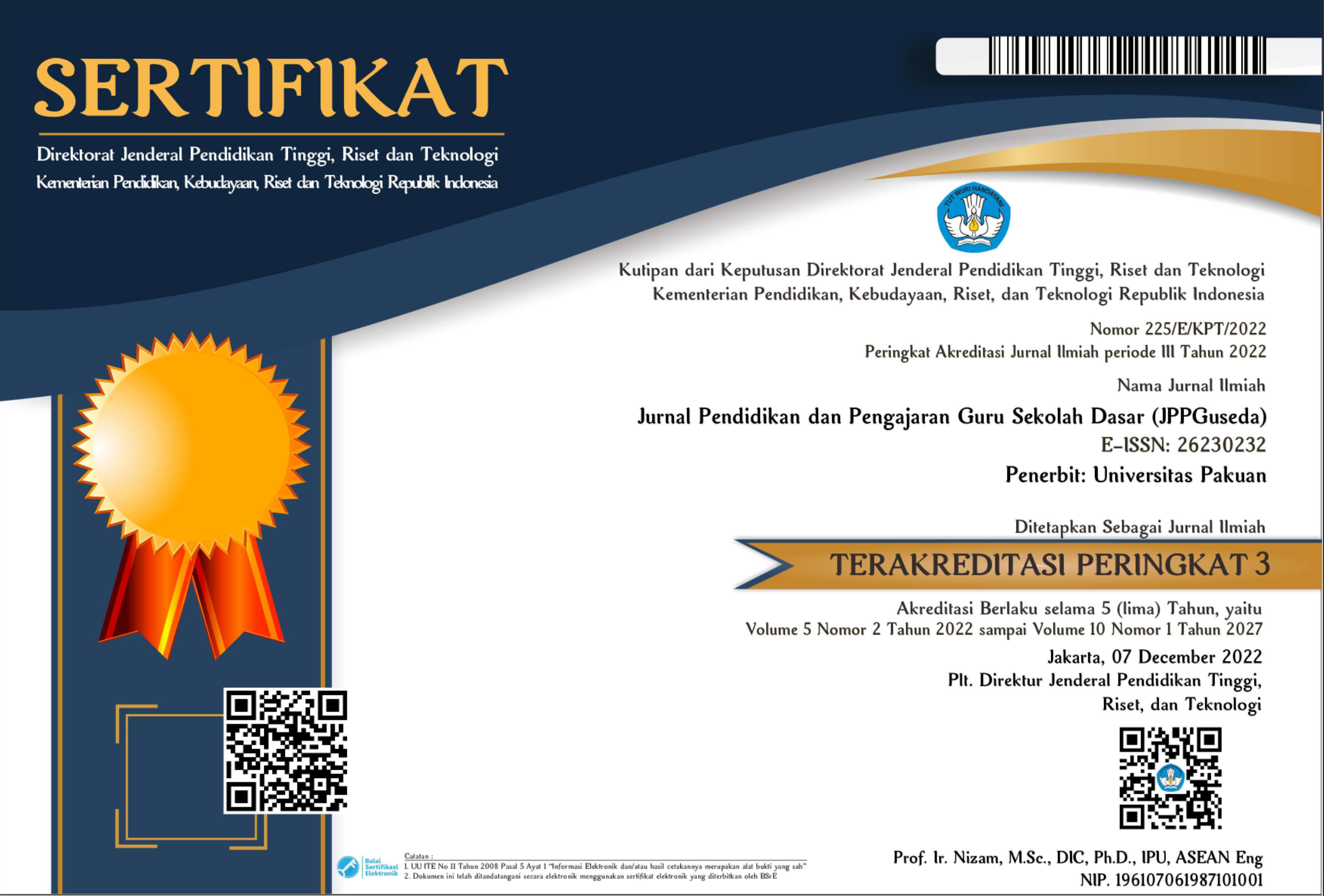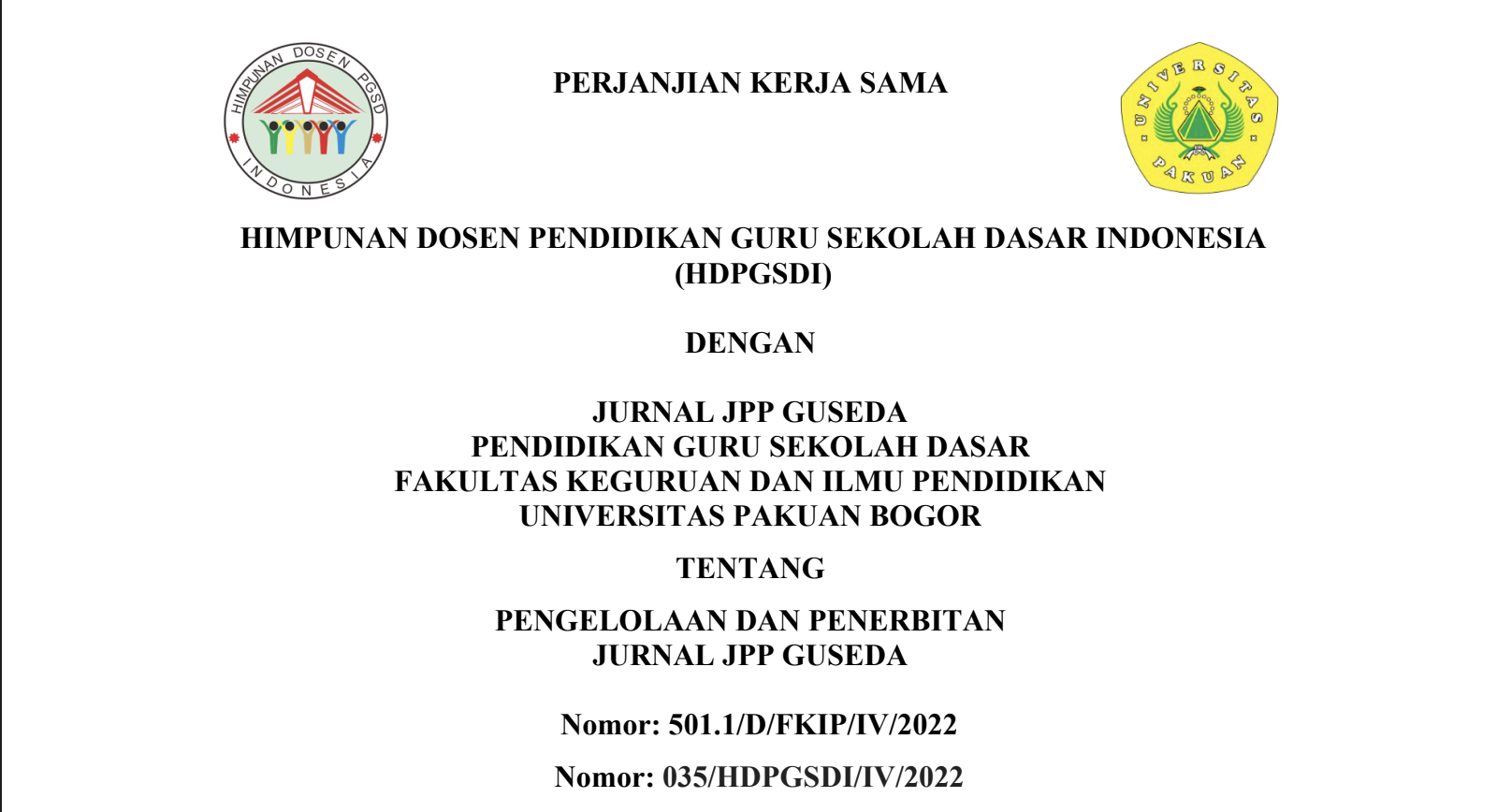ANALIS MINAT BELAJAR MAHASISWA PGSD PADA MATA KULIAH STRATEGI PEMBELAJARAN BERBASIS E-LEARNING
Abstract
This research uses qualitative method with descriptive design. The purpose of this study is to identify the students’s learning interest in the courses of learning strategy based E-Learning. This research was conducted to the students of primary school teacher education in faculty of teacher training and education study program, Pakuan University, Bogor. The data source of this research is the lecturers of the subjects of learning strategy in the Primary School Teacher Education. Informants in this study are the students of the primary school teacher education which registered as active student for academic 2013/2014. The results showed that all indicators of learning interest is well achieved. The involvement scored 4.2. the attention scored 4.2; the interest scored 4.1; and happiness scored 4.3. Based on the results of the percent, the results of all learning interest indicators achieved more than 60% of the involvement score is 67% , the attention is 86%; the interest is 75% ; and happiness is the highest result. It got 90%.
Keywords: learning interest, e-learning based learning strategy.
References
[1] Arikunto, Suharsimi. Metodologi Penelitian. Jogyakarta: Aksara. 21. 2003.
[2] Slameto. Belajar dan Faktor-Faktor yang mempengaruhinya.Jakarta: Rineka Cipta. 2003.
[3] Susanto, Ahmad. Teori Belajar & Pembelajaran di Sekolah Dasar. Jakarta:Kencana. 2013.
[4] Arifah, Fita. Menjadi guru teladan,kreatif, inspriratif, motifatif & profesional. Yogyakarta: Araska. 2016.
[5] Safari. Penulisan Butir Soal Berdasarkan Penilaian Berbasis Kompetensi. Jakarta: APSI Pusat. 2005.
[6] Djamarah, Syaiful. Psikologi Belajar. Jakarta: Rineka Cipta. 2011.
[7] Hamalik, Oemar. Metode Belajar dan Kesulitan Belajar. Bandung: Tarsito. 1983.
[8] Sanjaya, Wina. Perencanaan dan Desain Sistem Pembelajaran. Jakarta: Kencana Prenada Media Group. 99. 2008.
[9] Uno, Hamzah. Teori Motivasi dan Pengukurannya. Jakarta: Bumi Aksara. 3. 2008.
[10] Sunariah. Pengantar Pengetahuan Pasar Modal (Edisi 6). Yogyakarta: UPP STIM YKPN. 30. 2013.
[11] Rusmono. Strategi Pembelajaran dengan Based Learning itu Perlu: untuk Meningkatkan Profesionalitas Guru. Bogor: Ghalia Indonesia. 22. 2012.
[12] Surtikanti dan Santoso, Joko. Strategi Belajar Mengajar. Surakarta: UMS.31. 2008.
[13] Subadi. Ekonomi Pembangunan (cetakan kesatu) Bandung: Alfabetha. 118. 2011.
[14] Lukman, Dendawijaya. Manajemen Perbankan. Bogor: PT.Ghalia Indonesia. 24. 2006.
[15] Hartoyo. Upaya Meninkatkan Kinerja Pemeriksaan BPK RI Menggunakan Computer Assisted Audit Techinque (Improving the Performance of the Audit Board of Republic of Indonesi by using Computed Assisted Audit. Accessed Technique). e-Indonesia Initiatives. http://tif.bakrie.ac.id/pub/proc/eii/2011/ APT/ APT-01. pdf>116. 2012.
[16] Pranoto, Alvini.dkk. Sains dan Teknologi. Jakarta: PT Gramedia Pustaka Utama. 2009.
[17] Choy Tung, Lo. The Impact of Entrepreneurship Education on Entrepreneurial Intention of Enginnering Students. (Disertasi). Cityu University of Hongkong. 2007.
[18] Empy E. Zhuang H. E-Learning: Konsep dan Aplikasi. Yogyakarta: Andi Offset. 2005.
[19] Nursalam dan Ferry Efendi. Pendidikan dalam Keperawatan. Jakarta: Salemba Medika. 2008.
[20] Barokah, Dinar. Indikator Minat Belajar Siswa.. (http://pedomanskripsi.blogspot.com/2011/07/ indikator, diakses tanggal 10-08-2018 . 2011.
[21] Imran, Ali. Belajar dan Pembelajaran. Jakarta: Pustaka Jaya: 88. 1996.
[22] A.M.,Sardiman. Interaksi dan Motivasi Belajar Mengajar. Jakarta: Raja Grafindo Persada: 95. 2008.DOI: 10.55215/jppguseda.v1i1.867
 Abstract views : 2007
Abstract views : 2007
Refbacks
- There are currently no refbacks.
Copyright (c) 2018 JPPGuseda | Jurnal Pendidikan & Pengajaran Guru Sekolah Dasar




















